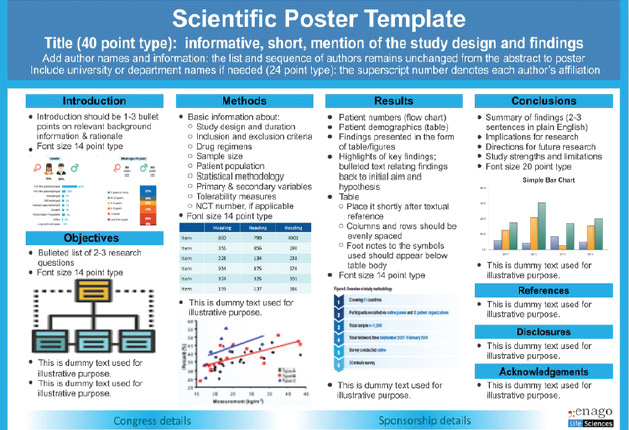Medical communications services encompass publications development, medical education/medico-marketing material, and event content development/management for a healthcare product or research. Scientific publications (manuscripts, abstracts, posters, and oral presentations) aid in disseminating clinical therapeutic area data to the scientific world and maintain transparency of the research outcome and interest in a medical brand. Publication of manuscript in the scientific journal generates peer-reviewed citable references. Whereas, presentation of the abstract, poster and oral presentation at scientific conferences (also known as congress) ensures research data are available in the public domain much ahead of the peer-reviewed publication.
Medical communications services usually include standalone or end-to-end conference support; starting from an abstract, poster/oral presentation, medical booth content, symposia slides, pre-and post-congress slide decks. Of these, posters services are a unique form of scientific communication; it is a combination of information and graphics. Generally, a poster service (print/electronic) includes content development, layout design, QR code, printing, and shipping to the designated venue (optional). Encore posters requiring only layout creation are also supported as a service.
Scientific Posters
The scientific poster presentation is a popular method of presenting research findings succinctly at meetings and conferences. Posters are a hybrid form of an oral presentation and a manuscript; it is more detailed and interactive than an oral presentation but less than a manuscript. Poster development includes two major elements, content and layout development. Content development requires expertise in presenting complex data into a succinct and simple form. The content is developed by experienced professional medical writers with profound scientific knowledge on the topic and writing skills. Poster layout is developed by graphic designers; they work closely with medical writers and ensure the scientific story is presented in a visual format as per the conference guidelines.
A good poster conveys the research as a simple, clear story in the form of bulleted text and images/ diagrams. The “W’s” (who, what, when, where, why) are an effective way to organize the
elements of a poster.1 The content of the poster should interest the audience and provide them with a clear take-home message that they can grasp in the few minutes they spend near the poster. Create the title, charts, and the text to emphasize the key message. The poster starts with a title, aim, background, methods, results, and concludes with the summary of findings and their implications for research. The best poster is a perfect mix of content, color, figures, font, and layout (Figure). In our next article, “Most Effective Tips When Presenting Your Scientific Poster”, we will share the prerequisites and tips on how to develop a good presentable poster.
Poster illustration: An effective poster with relevant and focused content under various headings

Reference
1. Jane E Miller. Preparing and Presenting Effective Research Posters. Health Serv Res. 2007 Feb; 42(1 Pt 1): 311–328.
Enago Life Sciences is a medical writing company with specialization in medical communications services. We provide a full poster (print / electronic format) and encore poster development services. We work closely with the authors/client to develop the poster from initiation up to final approval. A full poster is developed within a typical turnaround time of 6 weeks (kickoff – print ready file). Keeping the focus on the target audience, our team of writers and graphic designers convert your research into a simple succinct eye-catching poster. Our highly qualified, experienced team, with an excellent knowledge across therapy and industry standards, develop posters as per the conference guidelines and good publication practice.


How can we ensure that scientific and medical information is effectively communicated to both experts and the general public in a way that is accurate, engaging, and easily understandable?